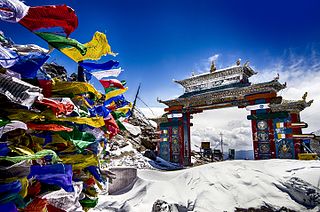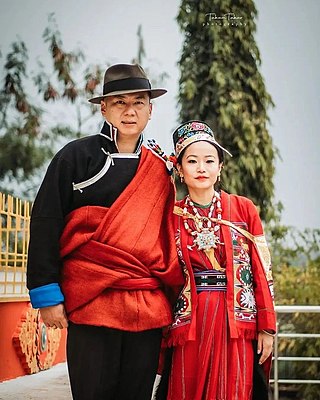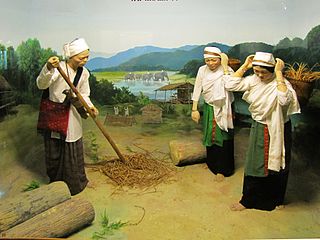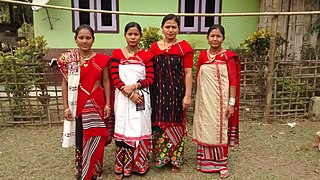Lhoba is any of a diverse amalgamation of Sino-Tibetan-speaking tribespeople living in and around Pemako, a region in southeastern Tibet including Mainling, Medog and Zayü counties of Nyingchi and Lhünzê County of Shannan, Tibet.

Arunachal Pradesh is a state in northeast India. It was formed from the North-East Frontier Agency (NEFA) region, and India declared it as a state on 20 February 1987. Itanagar is its capital and largest town. It borders the Indian states of Assam and Nagaland to the south. It shares international borders with Bhutan in the west, Myanmar in the east, and a disputed 1,129 km border with China's Tibet Autonomous Region in the north at the McMahon Line. It is disputed by China and claimed as part of Tibet, although this claim is internationally unrecognized and India maintains its control over the state. China occupied some regions of Arunachal Pradesh in 1962 but later withdrew its forces.

The Indo-Tibetan Border Police (ITBP) is a border guarding force of India deployed along its borders with Tibet Autonomous Region. It is one of the five Central Armed Police Forces, established in 1962 in the aftermath of the Sino-Indian War of 1962.

Northeast India, officially known as the North Eastern Region(NER) is the easternmost region of India representing both a geographic and political administrative division of the country. It comprises eight states—Arunachal Pradesh, Assam, Manipur, Meghalaya, Mizoram, Nagaland and Tripura (commonly known as the "Seven Sisters"), and the "brother" state of Sikkim.

The Monpa is a major tribe of Arunachal Pradesh in northeastern India. The Tawang Monpas have a migration history from Changrelung. The Monpa are believed to be the only nomadic tribe in Northeast India – they are totally dependent on animals like sheep, cow, yak, goats and horses. The Monpa have a very close affinity with the Sharchops of Bhutan.
The Buguns are one of the earliest recognized schedule tribe of India, majority of them, inhabiting the Singchung Sub-Division of West Kameng District of Arunachal Pradesh. Buguns live in several exogamous clans. Traditionally, the predominant occupation was agriculture, supported with other allied activities like fishing and hunting, cattle rearing etc. Buguns have their own folklores, songs, dances, music and rituals. A rare bird, the Bugun liocichla, was named after the tribe.

Tawang district is the smallest of the 26 administrative districts of Arunachal Pradesh state in northeastern India. With a population of 49,977, it is the eighth least populous district in the country.

The Adi people are one of the most populous groups of indigenous peoples in the Indian state of Arunachal Pradesh. A few thousand are also found in the Tibet Autonomous Region, where they are called the Lhoba together with some of the Nyishi people, Na people, Mishmi people and Tagin people.
The Nah people is a small tribal group residing in the Indian state Arunachal Pradesh. They speak the Na language, a member of the Sino-Tibetan language family, in which the population's literacy rate is 30%. The Na language has an affinity with the Tagin language. They also use Hindi or English. As of 2000, the tribal population stood at 1,500.

Yingkiong is a town in and the administrative headquarters of Upper Siang district in the Northeast Indian state of Arunachal Pradesh. It is located 250 kilometres (160 mi) north of Itanagar, the capital of the state, and 1 kilometre (0.62 mi) east of the River Siang. According to the 2011 Census, the town has a total population of 8,573.
Tani, is a branch of Tibeto-Burman languages spoken mostly in Arunachal Pradesh, Assam, and neighboring regions.

Tawang is a town and administrative headquarter of Tawang district in the Indian state of Arunachal Pradesh. It lies on NH-13 section of Trans-Arunachal Highway. The town was once the capital of the Tawang Tract, which is now divided into the Tawang district and the West Kameng district. Tawang continues as the headquarters of the former. Tawang is the number one tourist destination of Arunachal Pradesh.
Tshangla is a Sino-Tibetan language of the Bodish branch closely related to the Tibetic languages. Tshangla is primarily spoken in Eastern Bhutan and acts as a lingua franca in the region; it is also spoken in the adjoining Tawang tract in the Indian state of Arunachal Pradesh and the Pemako region of Tibet. Tshangla is the principal pre-Tibetan language of Bhutan.

The Tai Khamti, also known as the Hkamti Shan or simply as Khamti, are a Tai ethnic group of India, China and Myanmar. The Tai-Khamti are followers of Theravada Buddhism. The Tai-Khamti have their own script for their language, known as 'Lik Tai', which originated from the Shan (Tai) script of Myanmar. Their mother tongue is known as Khamti language. It is a Tai language, closely related to Thai and Lao.
The Tani people are a Sino-Tibetan ethnic group of peoples, which includes the Nyishi, Adi, Apatani, Galo, Tagin, and Mishing, who share common beliefs, ancestry, and Tani languages and live in the Indian states of Arunachal Pradesh and Assam, as well as the Tibet Autonomous Region in China.
Bardo Chham is a folk dance traditional to the Himalayan Buddhist Tribes of Arunachal Pradesh, India. Here in, "Bardo" means "the limbo between death and rebirth" in Tibetan Buddhism, as under the Tibetan Book of Dead. While Chham, literally translates to "Dance" in Tibetan. Bardo Chham is based on the stories of the triumph of good over evil. According to the local beliefs, both good and evil exists within mankind. The dance is portrayed with the use of traditional wooden masks, representing the different animals and characters there in.

The Mising people are a Sino-Tibetan ethnic group inhabiting mostly in the Northeast Indian states of Assam and Arunachal Pradesh. They are part of the greater Tani group of people of India and Tibet Autonomous Region of China.
Here is a list of glossary of Culture of India in alphabetical order:

Shi Yomi district is one of the 23 districts of Arunachal Pradesh state in northeastern India. Shi-Yomi district was created on 9 December 2018 by dividing the West Siang district when northern areas along the China border were made into a newly created Shi-Yomi district and the remaining southern areas remain the part truncated West Siang district. It has its headquarters at Tato.
Kepang La or Kapang La is a mountain pass on the Indo-Tibetan Line of Actual Control near the course of the Yarlung Tsangpo river. It separates the Mêdog County of Tibet from the Upper Siang district of India's Arunachal Pradesh.










